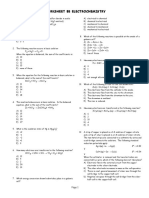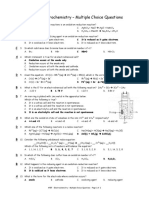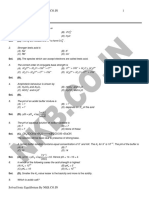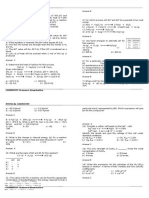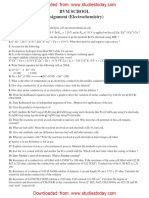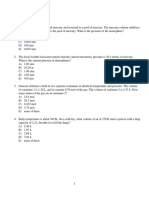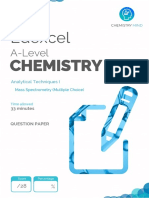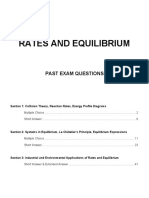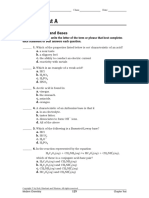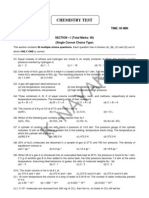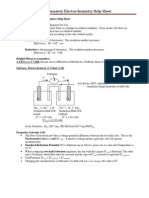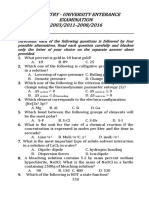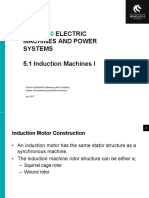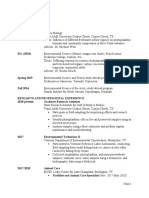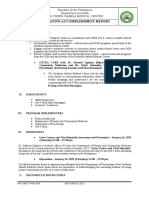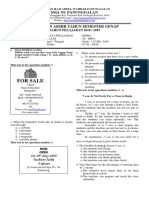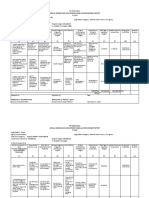APEF - Electrochemistry - Multiple Choice Questions - Page 1 of 2
APEF - Electrochemistry - Multiple Choice Questions - Page 1 of 2
Uploaded by
alyaa sheirCopyright:
Available Formats
APEF - Electrochemistry - Multiple Choice Questions - Page 1 of 2
APEF - Electrochemistry - Multiple Choice Questions - Page 1 of 2
Uploaded by
alyaa sheirOriginal Description:
Original Title
Copyright
Available Formats
Share this document
Did you find this document useful?
Is this content inappropriate?
Copyright:
Available Formats
APEF - Electrochemistry - Multiple Choice Questions - Page 1 of 2
APEF - Electrochemistry - Multiple Choice Questions - Page 1 of 2
Uploaded by
alyaa sheirCopyright:
Available Formats
APEF Electrochemistry Multiple Choice Questions
A 1. Which of these chemical reactions is an oxidation-reduction reaction?
A. Fe + S FeS C. AgNO3 + NaCl AgCl + NaNO3
B. CO2 + H2O H2CO3 D. H2SO4 + 2NaOH Na2SO4 + 2H2O
C 2. What happens to the oxidizing agent in an oxidation-reduction reaction?
A. It is oxidized as it gains electrons. C. It is reduced as it gains electrons.
B. It is oxidized as it loses electrons. D, It is reduced as it loses electrons.
C 3. In which substance does bromine have an oxidation number of +1?
A. Br2 B. HBr C. HBrO D. HBrO2
A 4. Which statement is true for an electrochemical cell?
A. Oxidation occurs at the anode only.
B. Reduction occurs at the anode only.
C. Oxidation occurs at both the anode and cathode.
D. Reduction occurs at both the anode and cathode.
D 5. Given the equation: 2Cr(s) + 3Pb2+(aq) 2Cr3+(aq) + 3Pb(s), which is the correct reduction half reaction?
A. Cr(s) Cr3+(aq) + 3e- C. Pb2+(aq) Pb(s) + 2e-
-
B. 3+
Cr(s) + 3e Cr (aq) D. Pb2+(aq) + 2e- Pb(s)
B 6. What is the E for an electrochemical cell with the following reaction? 2Au3+ + 3Co 3Co2+ + 2Au
A. -1.22 V B. 1.78 V C. 1.22 V D. 3.84 V
D 7. An iron ring is plated with zinc metal in the apparatus below.
Which of the following is true?
A. It is a voltaic cell and the reaction is spontaneous.
B. It is a voltaic cell and the reaction is not spontaneous.
C. It is an electrolytic cell and the reaction is spontaneous.
D. It is an electrolytic cell and the reaction is not spontaneous.
A 8. What are the oxidation state of vanadium in the ions VO2+ and VO43- respectively?
A. +4 and +5 B. +4 and +8 C. +6 and +5 D. +6 and +8
D 9. Which one of the following reactions is a redox reaction?
A. Pb2+(aq) + 2Cl-(aq) PbCl2(s) C. NaOH(aq) + HCl(aq) NaCl(aq) + H2O(l)
B. AgNO3(aq) + HCl(aq) AgCl(s) + HNO3(aq) D. 2Al(s) + 3Cl2(g) 2AlCl3(s)
B 10. Consider the following unbalanced redox equation:
__CH3OH(l) + __Cr2O72-(aq) + __H+(aq) __CH2O(aq) + __ Cr3+(aq) + __H2O(l)
Which of the following sets of numbers will balance the equation?
A. 1, 1, 14, 1, 2, 7 B. 3, 1, 8, 3, 2, 7 C. 3, 1, 8, 3, 2, 8 D. 3, 1, 14, 3, 2, 8
D 11. In which of the following does sulfur have an oxidation number of +7?
A. HSO3- B. SO3 C. H2SO4 D. H2S2O8
B 12. What happens to the reducing agent in an oxidation-reduction reaction?
A. It is oxidized as it gains electrons. C. It is reduced as it gains electrons.
B. It is oxidized as it loses electrons. D. It is reduced as it loses electrons.
A 13. What is the term for the electrode where oxidation occurs?
A. anode B. cathode C. oxidizing agent D. reducing agent
APEF Electrochemistry Multiple Choice Questions - Page 1 of 2
B 14. Which of the following is true for an electrolytic cell?
A. An electric current is produced by a chemical reaction.
B. A nonspontaneous reaction is forced to occur.
C. Electrons flow towards the anode.
D. Electrons flow through the salt bridge.
A 15. Which species is the oxidizing agent in the following reaction? Cl2(aq) + 2I-(aq) I2(aq) + 2Cl-(aq)
A. Cl2 B. I- C. I2 D. Cl-
C 16. Which of the following statements is true for the reaction: 2Fe3+(aq) + 2Br-(aq) 2Fe2+(aq) + Br2(l)
A. E = -1.83 V and it is not spontaneous C. E = -0.29 V and it is not spontaneous
B. E = +0.29 V and it is spontaneous D. E = +1.83 V and it is spontaneous.
D 17. The cell potential, E, for an oxidation-reduction reaction was found to equal 1.10 V. What can be said
about this reaction?
A. at equilibrium B. endothermic C. nonspontaneous D. spontaneous
C 18. The diagram shows the electrolysis of molten KCl. What occurs when the switch is closed?
A. Positive ions move toward the anode and gain electrons.
B. Positive ions move toward the anode and lose electrons.
C. Positive ions move toward the cathode and gain electrons.
D. Positive ions move toward the cathode and lose electrons.
D 19. Consider the following standard reduction potentials:
2H+ + 2e- H2 E = 0.00 V
Sn2+ + 2e- Sn E = -0.14 V
Cd2+ + 2e- Cd E = -0.40 V
Which pair of substances will react spontaneously?
A. Sn with Cd2+ B. Cd2+ with H+ C. Cd with H2 D. Cd with Sn2+
B 20. What does the reducing agent do in an oxidation-reduction reaction?
A. gains electrons from the oxidizing agent C. is always reduced
B. loses electrons to the oxidizing agent D. is reduced by the oxidizing agent
C 21. In these incomplete half-reactions which reactant is an oxidizing agent?
Ag(s) Ag+(aq)
Cl-(aq) Cl2(g)
Fe3+(aq) Fe2+(aq)
Sn2+(aq) Sn4+(aq)
A. Ag(s) B. Cl-(aq) C. Fe3+(aq) D. Sn2+(aq)
D 22. What is the oxidation number of nitrogen in nitric acid, HNO3?
A. +2 B. +3 C. +4 D. +5
A 23. In an electrochemical cell, electrons travel in which direction?
A. from the anode to the cathode through the external circuit
B. from the anode to the cathode through the porous cup
C. from the cathode to the anode through the external circuit
D. from the cathode to the anode through the porous cup.
A 24. In the reaction of Sn2+ with ClO3- to form Cl- and Sn4+ in acid solution, what is the change in the oxidation
number of Cl?
A. a decrease of 6 B. a decrease of 4 C. a decrease of 2 D. an increase of 2
APEF Electrochemistry Multiple Choice Questions - Page 2 of 2
You might also like
- Musical Sleep Lamp: User ManualDocument2 pagesMusical Sleep Lamp: User ManualAngel ValdertellzNo ratings yet
- Sample Problems in ElectrochemistryDocument19 pagesSample Problems in ElectrochemistrygiyagirlsNo ratings yet
- Confidential InformationDocument1 pageConfidential InformationJose HansonNo ratings yet
- Unit 5 Practice Test Multiple ChoiceDocument10 pagesUnit 5 Practice Test Multiple ChoiceMadhavan Vijay100% (1)
- واجب شامل للمقررDocument30 pagesواجب شامل للمقررOsama AlkinaneNo ratings yet
- Topical Test Echem 2014Document1 pageTopical Test Echem 2014irnihafizan6812No ratings yet
- Tutorial 4 - ElectrochemistryDocument3 pagesTutorial 4 - ElectrochemistryAnis IssabellaNo ratings yet
- Unit 8B AP Chem - ElectrochemistryDocument11 pagesUnit 8B AP Chem - ElectrochemistryAnivia12100% (1)
- Test4 Ch19 Electrochemistry Practice ProblemsDocument13 pagesTest4 Ch19 Electrochemistry Practice ProblemsPhysiochemo Chemical100% (1)
- APEF Electrochem MC Ans PDFDocument2 pagesAPEF Electrochem MC Ans PDFFirdausia Rahma PutriNo ratings yet
- Topic 9 19 MC PracticeDocument18 pagesTopic 9 19 MC PracticeDharmesh Ramnarayan Yadav100% (1)
- Chemistry - Test ElectrochemistryDocument12 pagesChemistry - Test Electrochemistrypolamraju100% (2)
- Electrochemistry Multiple ChoicegovtDocument32 pagesElectrochemistry Multiple ChoicegovtLokesh Khobragade100% (3)
- Grade 12 Practice QuestionsDocument10 pagesGrade 12 Practice Questionsnahil ahmedNo ratings yet
- Unit - 9 Ionic Equilbrium: Multiple Choice QuestionsDocument25 pagesUnit - 9 Ionic Equilbrium: Multiple Choice QuestionsSAMBASIVA RAO YEMINENINo ratings yet
- Solved Multiple Choice Questions IE by NKB - PDF 116788864Document15 pagesSolved Multiple Choice Questions IE by NKB - PDF 116788864Pranav SharmaNo ratings yet
- Assignment 151Document5 pagesAssignment 151Hai Xuan DoNo ratings yet
- A. Strong Acid, Weak Base, Salt: Final Examination Subject: General Chemistry A. Subject Code: 604001Document6 pagesA. Strong Acid, Weak Base, Salt: Final Examination Subject: General Chemistry A. Subject Code: 604001TanNo ratings yet
- JRS PhyChemDocument13 pagesJRS PhyChemsalazarjoelNo ratings yet
- Problems ElectrochemistryDocument11 pagesProblems ElectrochemistryorlandompsilvaNo ratings yet
- CBSE Class 12 Chemistry Worksheet - ElectrochemistryDocument4 pagesCBSE Class 12 Chemistry Worksheet - ElectrochemistryArya Verma100% (1)
- Atomic Structure: Examples of Multiple Choice QuestionsDocument4 pagesAtomic Structure: Examples of Multiple Choice Questionsngah lidwineNo ratings yet
- VI Baltic Chemistry OlympiadDocument2 pagesVI Baltic Chemistry OlympiadYarga Puritza100% (1)
- ElectrochemDocument75 pagesElectrochemMhyl HitsuyagamikaelsonNo ratings yet
- Electrochemistry: 0 8 0 79 0 34 2 37 Ag / Ag - HG / HG - Cu / Cu - MG / MGDocument11 pagesElectrochemistry: 0 8 0 79 0 34 2 37 Ag / Ag - HG / HG - Cu / Cu - MG / MGAnikin Skywalker100% (1)
- Electrolysis Worksheet 2Document11 pagesElectrolysis Worksheet 2Menaga A/P IlangkovanNo ratings yet
- CHEM311 211 Major2 SolvedDocument9 pagesCHEM311 211 Major2 SolvedhussainNo ratings yet
- Thermochemistry Multiple ChoiceDocument17 pagesThermochemistry Multiple ChoiceEvoli NatasNo ratings yet
- Equilibrium Practice TestDocument13 pagesEquilibrium Practice Testdeckbyte865No ratings yet
- Rates of Reaction TestDocument10 pagesRates of Reaction TestSaya MenangNo ratings yet
- Work Sheet For G10Document2 pagesWork Sheet For G10Firaol GeremuNo ratings yet
- Module 1 - Electrochemical EnergyDocument129 pagesModule 1 - Electrochemical EnergyknightruzelNo ratings yet
- MCQ Chapter 2 ElectrochemistryDocument4 pagesMCQ Chapter 2 ElectrochemistrySavien Brandan100% (1)
- Multiple Choice Questions: CH (G) 5O (G) 3CO (G) 4H O (L) + ® +Document5 pagesMultiple Choice Questions: CH (G) 5O (G) 3CO (G) 4H O (L) + ® +Abhay VishwakarmaNo ratings yet
- KSP MCQDocument5 pagesKSP MCQalvin2282No ratings yet
- Sample Questions - Chapter 12Document7 pagesSample Questions - Chapter 12Rasel IslamNo ratings yet
- Redox Review With ANSWERS - 4Document13 pagesRedox Review With ANSWERS - 4AYESHA NAAZNo ratings yet
- Mcqs of Inorganic and Physical Chemistry by Malik XufyanDocument29 pagesMcqs of Inorganic and Physical Chemistry by Malik XufyanMalikXufyanNo ratings yet
- Buffers&titrationsquestions ReviewDocument6 pagesBuffers&titrationsquestions Reviewapi-279595789No ratings yet
- AP Chemistry: Electrochemistry Multiple Choice: Which of The Above Occurs For Each of The Following Circumstances?Document5 pagesAP Chemistry: Electrochemistry Multiple Choice: Which of The Above Occurs For Each of The Following Circumstances?Mohammed AbdelhakeemNo ratings yet
- Electrochemistry: WWW - Crackjee.xyzDocument8 pagesElectrochemistry: WWW - Crackjee.xyzRashmi Ranjan DasNo ratings yet
- Addu High School Hithadhoo/Addu C TOPIC: ENTROPY-Enthalpy of Solution Worksheet 2Document8 pagesAddu High School Hithadhoo/Addu C TOPIC: ENTROPY-Enthalpy of Solution Worksheet 2Neen NaazNo ratings yet
- Test2 Ch17a Acid-Base Practice Problems PDFDocument12 pagesTest2 Ch17a Acid-Base Practice Problems PDFRaphael CastilloNo ratings yet
- S Block QuestionsDocument9 pagesS Block QuestionsZaid Khan100% (1)
- 10.1 Galvanic CellsDocument2 pages10.1 Galvanic CellsElla Leduc100% (1)
- Practice Questions For Ch. 5: Name: - Class: - Date: - Id: ADocument23 pagesPractice Questions For Ch. 5: Name: - Class: - Date: - Id: APrem MehrotraNo ratings yet
- Test BanksDocument21 pagesTest Banksalex_flutistNo ratings yet
- Mass Spectrometry (Multiple Choice) QPDocument12 pagesMass Spectrometry (Multiple Choice) QPYusuf AlamNo ratings yet
- FC Sec B Assignment 6 2021 (Answer)Document5 pagesFC Sec B Assignment 6 2021 (Answer)Bhagabana MuniNo ratings yet
- Equilibrium Exam QuestionsDocument58 pagesEquilibrium Exam QuestionsMadi B100% (1)
- Gibbs WorksheetDocument4 pagesGibbs WorksheetDon'tAsK TheStupidOnesNo ratings yet
- 70 Practice Problems For CH 7Document10 pages70 Practice Problems For CH 7ULFA TUFFAHATINo ratings yet
- Modern Chemistry Chapter Test :ADocument6 pagesModern Chemistry Chapter Test :ARayan AltamimiNo ratings yet
- PLTL Ch. 16 AssignmentDocument6 pagesPLTL Ch. 16 AssignmentJules BrunoNo ratings yet
- IIT Jee Mayank Test-2Document5 pagesIIT Jee Mayank Test-2kamalkantmbbsNo ratings yet
- CHE 160 Semester Review Zumdahl CH 5-7Document20 pagesCHE 160 Semester Review Zumdahl CH 5-7Kinal PatelNo ratings yet
- 3B-HYDROCARBON Assignment - FinalDocument49 pages3B-HYDROCARBON Assignment - Finalkraken monsterNo ratings yet
- Chapter 20 - ElectrochemistryDocument5 pagesChapter 20 - ElectrochemistrySai SanigepalliNo ratings yet
- Chem G12 FiveYearsNationalExamDocument75 pagesChem G12 FiveYearsNationalExamTeklay NegasiNo ratings yet
- Acid Base - Q - MSDocument41 pagesAcid Base - Q - MSAnonymous ANo ratings yet
- Organometallic Transition Metal Catalysis: A Holistic Approach to Understanding and Predicting their MechanismsFrom EverandOrganometallic Transition Metal Catalysis: A Holistic Approach to Understanding and Predicting their MechanismsNo ratings yet
- ELEC3130: Electric Machines and Power Systems 5.1 Induction Machines IDocument23 pagesELEC3130: Electric Machines and Power Systems 5.1 Induction Machines Isaif thuraonNo ratings yet
- Tiffany Chin CVDocument4 pagesTiffany Chin CVapi-455548272No ratings yet
- Delayed Coking: Chapter 5Document34 pagesDelayed Coking: Chapter 5Arumugam Ramalingam100% (1)
- Survey ReportDocument21 pagesSurvey ReportArghya BhuiyanNo ratings yet
- Wage DistortionDocument1 pageWage DistortionJurizLexNo ratings yet
- Basic Communication As NutritionistsDocument58 pagesBasic Communication As NutritionistsRima AuliyaNo ratings yet
- Radio Program Liver Cancer and Depression 0126223 NarrativeDocument5 pagesRadio Program Liver Cancer and Depression 0126223 NarrativeMae Francesca Isabel GarciaNo ratings yet
- Multi Power Monitor: Operating ManualDocument53 pagesMulti Power Monitor: Operating ManualKoko Setyo NugrohoNo ratings yet
- Tummo Instructuons by LocoDocument29 pagesTummo Instructuons by Locobv.ahernandezmorchioNo ratings yet
- Soal Bdsi XiDocument6 pagesSoal Bdsi XiPrudence SuryaniNo ratings yet
- E 698 - 99 - Rty5oc1sruqDocument10 pagesE 698 - 99 - Rty5oc1sruqtam daoNo ratings yet
- DCI Yearbook 2011 PDFDocument256 pagesDCI Yearbook 2011 PDFGaetan DufourNo ratings yet
- Chapter IIDocument3 pagesChapter IIHarold Emmanuel Mascariñas LlonaNo ratings yet
- Ad226 LeafletDocument4 pagesAd226 LeafletSanti YuliandariNo ratings yet
- Stock 09 OktoberDocument28 pagesStock 09 OktoberGigih Kenanga SariNo ratings yet
- Promised Land State Park PDFDocument2 pagesPromised Land State Park PDFAlbertNo ratings yet
- 11 BibliographyDocument24 pages11 BibliographyMehmudNo ratings yet
- Nicole Smith (Case Note)Document3 pagesNicole Smith (Case Note)Duan TianNo ratings yet
- Accident Investigation Method. - .Document80 pagesAccident Investigation Method. - .Sunil Jaglan100% (1)
- Online Car Breakdown Service ERT-426: Submitted byDocument11 pagesOnline Car Breakdown Service ERT-426: Submitted byPrashant TriveniNo ratings yet
- Dramatic Play: To Help Support Dramatic Play at Home Try Some of The Following StrategiesDocument2 pagesDramatic Play: To Help Support Dramatic Play at Home Try Some of The Following StrategiesShawna PassmoreNo ratings yet
- Article 21 Ccontentions and CasesDocument1 pageArticle 21 Ccontentions and CasesSakshi mishraNo ratings yet
- 3A Steam Jet Heaters BrochureDocument16 pages3A Steam Jet Heaters Brochurealfonso salamanca echeverriNo ratings yet
- Biotic and Abiotic Characteristics of Terrestrial and Aquatic Biomes NotesDocument12 pagesBiotic and Abiotic Characteristics of Terrestrial and Aquatic Biomes Notesapi-417027192100% (1)
- 2022 GAD Annual Plan and Budget New FormatDocument3 pages2022 GAD Annual Plan and Budget New FormatMerill FriasNo ratings yet
- Nwabshah Children HospitalDocument6 pagesNwabshah Children HospitalJunaid AhmedNo ratings yet
- Postnatal ExaminationDocument19 pagesPostnatal ExaminationAlpha100% (1)
- Issues of DebenturesDocument30 pagesIssues of Debenturesiloveyousanjay50% (2)







